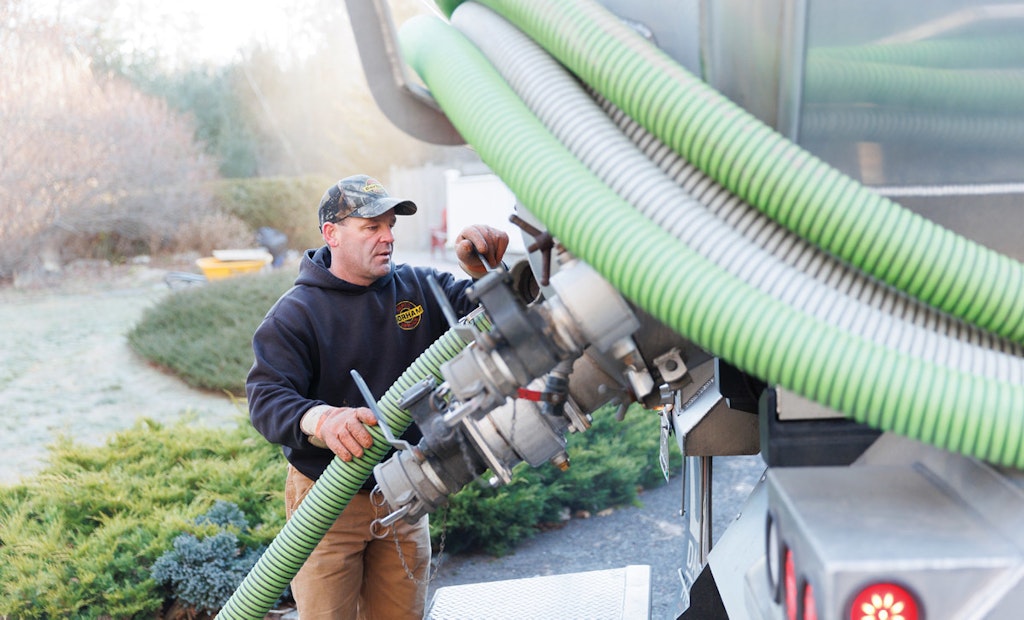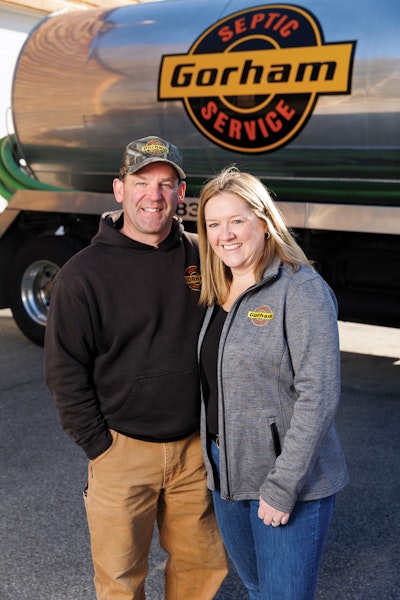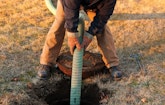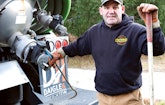
Jeremy Hamblen prepares to pump another septic tank. His new truck carries a bigger load, improving efficiency for a one-man, one-truck operation.
Interested in Trucks?
Get Trucks articles, news and videos right in your inbox! Sign up now.
Trucks + Get AlertsOver the years, Jeremy Hamblen has developed a business philosophy that’s as simple and basic as Gorham Septic, the one-man pumping company he owns and operates in Gorham, a city just northwest of Portland in southern Maine.
“I provide the best service I can for people,” says Hamblen, 46. “I’m honest with customers. I charge a fair price. And all I do is pump septic tanks.
“I know I’m not going to get rich and retire at age 50 or anything like that,” he adds. “But this job allows me to do the things my family wants to do. It’s done good by me — I made a good choice.”
Many pumpers can no doubt relate to Hamblen’s career arc. After graduating from high school, he held several construction-related jobs for a while, worked for a logging company and then jumped into the excavation field.
“I was at a point where I was generating enough business that I’d need to hire a few guys and buy some new equipment,” he recalls. “But I didn’t want to deal with employees, so I kept an eye out for a company I could run by myself.”
Then he heard about Gorham Septic. “I immediately thought, ‘That’s something I could do by myself,’” he recalls. But the owner, Donnie Keene, told me he was too young to sell the company.
A short time later, Keene told Hamblen about a septic pumping company that was for sale, Yarmouth Septic, based in nearby North Yarmouth. Hamblen bought that company in 2004 and moved it to Gorham.
Business was slow at first; Hamblen held down several part-time jobs for the next six or seven years before there was enough business to sustain working full time.
But then came the game-changer: In 2016, Keene told Hamblen he wanted to sell Gorham Septic. Today, about 75% of the company’s revenue comes from pumping residential septic tanks, while pumping commercial tanks generates the balance, he says.
LONG HARD HOURS
Operationally, the business hasn’t changed all that much since Hamblen bought it. The entrepreneur still works alone, preferring to avoid the headaches that come with hiring and managing employees; and he hasn’t added any services, opting instead to focus on doing one thing really well.
“I stay pretty busy just pumping tanks,” Hamblen says, noting that buying Gorham Septic more than doubled the size of his business, leaving him no time to provide other service. On an average day, he pumps eight to 12 tanks and routinely puts in 10- to 12-hour days.
“The year before I bought Gorham Septic, I was pumping 660 tanks a year,” he says. “Now I do about 2,000 tanks a year.”
How does he keep up that pace?
“I don’t know,” he says with a laugh. “I just do it. The schedule book is full, so you have to get the jobs done.”
What if customers need other services, such as repairs or installations? Hamblen says he refers to them to several other local companies with which he’s developed good business relationships.
“I only recommend companies that I’d feel comfortable having work at my house,” he says.
BIG RIG PROVIDES A BOOST
The huge increase in volume did spur one big change: The purchase of a truck with a significantly bigger tank — about 43% more capacity than the 2,800-gallon tank on the 2018 International truck that came with the business purchase.
“With the much larger volume of work, the old truck just wasn’t cutting it anymore — I was making too many trips to the treatment plant,” Hamblen explains. “One plant is in Sanford, about 30 miles away, and the treatment center in Portland is 10 or 15 miles away.”
So Hamblen invested in a 2020 Western Star truck equipped with a 4,000-gallon aluminum tank built by Imperial Industries. The truck also features a Challenger 887 vacuum pump (532 cfm) made by National Vacuum Equipment.
The truck quickly paid dividends by substantially reducing weekly windshield time for Hamblen and decreasing fuel costs and vehicle wear and tear.
“The bottom line is I can get a lot more work done each day,” he says.
Hamblen says he doesn’t spend a lot of money on marketing his business. For starters, Gorham Septic was 40 years old when he bought it, so the company already had established a solid reputation and built up good brand recognition. Word-of-mouth referrals are the company’s best form of advertising, he says.
“If you do the best work you can and treat customers good, they’ll stay with you and also get you more customers by spreading your name around,” he says.
“Another reason I keep growing is that I charge a fair price,” he says. “I’m usually not the highest or the lowest. I’m in the middle, so to me, that’s a fair price. I’m not cheating myself just to get work and then not making any money, but I’m not over-charging, either.
“Sure, I want to make money,” he continues. “But I also like to sleep good at night.”
MANY COMPETITORS
Charging a competitive rate is important because there are five other small pumping businesses in the area, as well as a couple of larger companies. But Hamblen says he doesn’t reduce his prices to match those charged by low-balling companies.
“We’re all usually within $15 of each other,” he says. “But newer guys seem to lowball more because there’s always a small amount of people who make decisions about pumpers based only on price.
“I’ve had some customers tell me my prices are too low,” he continues. “But I’ve also had people ask me to match a price $5 cheaper than me. I tell them absolutely not. I’d rather lose a job then drop my price. When people work at my house for, say, a refrigerator repair, and they charge me $200, I don’t ask for a discount. It’s just the principle of the thing.”
Hamblen also gives his wife, Karen, credit for the company’s success. She started helping him on a part-time basis in mid-2020, handling things such as invoicing, paying bills and other administrative tasks.
“Before she came on board, I did everything,” he says, noting she also holds a second part-time job. “So having her around has been a huge help. At the end of a long day, I don’t have to sit down and work some more.”
STEADY GOING
Hamblen doesn’t have big plans for future growth. “I can’t do much more than I’m already doing,” he says. “I’m already giving someone else my riser work because I just don’t have time.”
Hamblen also doesn’t want to diversify by adding more services, which would offer another path to growth. “When you try to diversify, you sometimes lose focus on one thing in order to make something else work,” he explains. “So I’d rather keep things simple and do what I do.”
Furthermore, diversification would require Hamblen to hire at least one full-time employee, a road he doesn’t want to drive down.
“It’s hard to find someone who wants to work in this industry — you need to have the right mindset for this job,” he adds. “And even if I could find someone to hire, you’d have to pay them top dollar.” As such, Hamblen says he’s content to maintain what he has.
“I always grow a little bit each year,” he says. “But at some point, that’ll come to a halt and business will plateau. But I’ll be pretty happy with that.”












